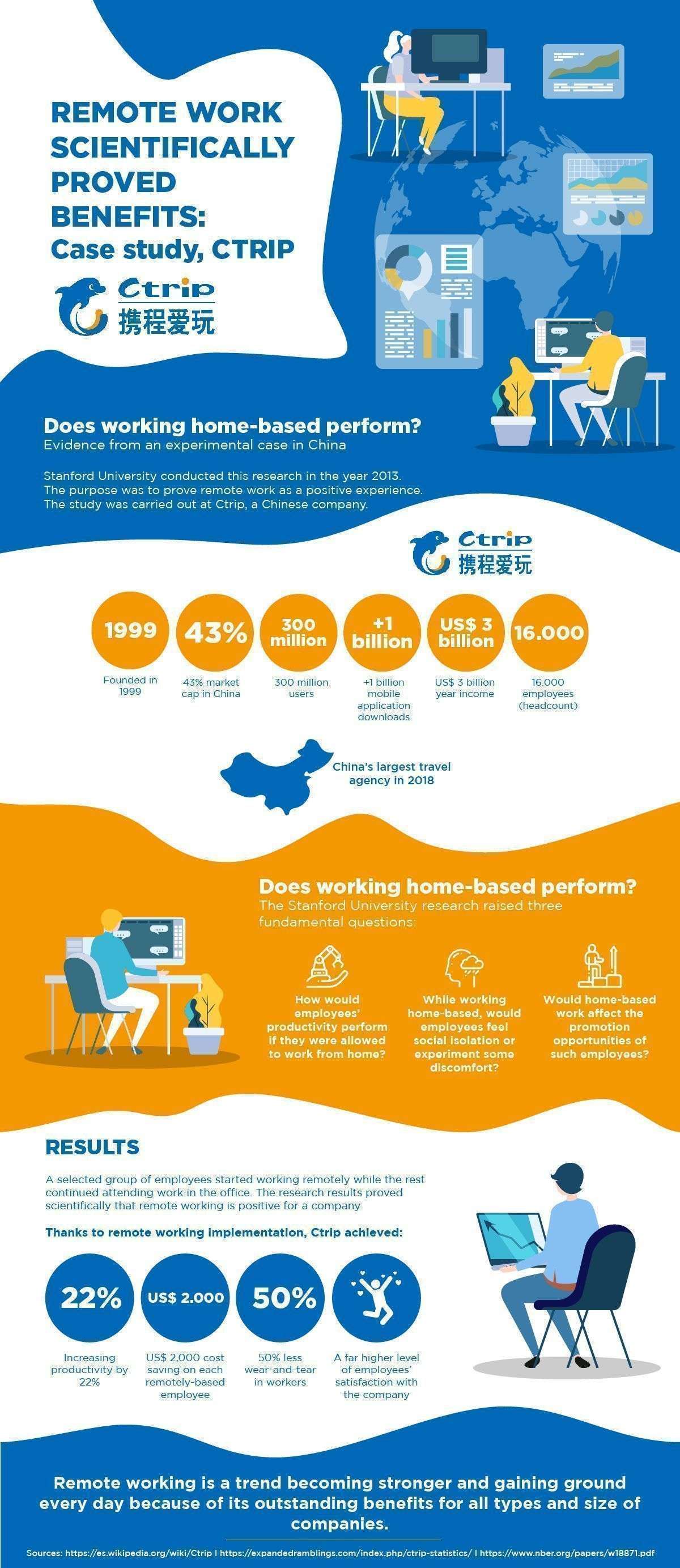Probably you have already read many of our posts listing the enormous advantages of remote work. However, when it comes to implementing this mode into your business, it is highly understandable that you want to make sure this is a good choice and not just theoretically positive.
Fortunately, since many international companies are daring to change their paradigm, we increasingly have more and more evidence remote work and freelancers function amazingly.
One of the most outstanding cases that exist is the incredible results achieved by one of the largest firms in China when started migrating into this labor scheme. We are referring to Ctrip, a colossal travel agency with central offices in Shanghai and a headcount above 16,000 employees.
The company carried out a theoretical/practical study about remote work among its employees obtaining amazing results:
- Increased productivity by 22%
- An estimated annual saving of around US$ 2,000 on each employee. Though the number may not look relevant, if we keep in mind the total number of employees being 16,000, savings stand for billions.
Before we get deep into a thorough analysis of this case, we will share some of the highlight points of the following infographic so that you can understand with one look the magnitude and importance of this study. Additionally, this will enable you to check how beneficial remote working could be to your business, by applying this pattern as a rule or by hiring freelancers (who, of course, would work under this work manner).

At Workana we want to provide you with useful and hard data so that you are encouraged to test remote work and scale your business by hiring freelancers.
Therefore, today we present a practical and documented case that shows how CTrip gave a chance to remote work, achieving such good results that now, all the staff has been allowed to choose working home-based. Let’s go forward step-by-step through this exciting example.
“Does working home-based perform? Evidence from an experiment in China”
The above is the name of a report written by Nicholas Bloom, a Stanford University researcher, published in the year 2013 and based on an experiment conducted jointly with the Chinese Ctrip, a massive travel agency with a headcount of more than 16,000 employees.
Bloom was aware that though nearly 10% of United States’ population works from home on a regular basis, companies still raised many concerns: they felt that losing face-to-face control over their employees would threat their productivity to decrease drastically.
The researcher conviction was that remote work carries precisely the opposite effects: it can optimize the balance between personal life and work, and it is plausible of implementation even on large-scale companies and different professions alike.
Nevertheless, the available evidence at that time was not enough to prove his hypothesis. Therefore, he decided to find it out himself.

The perfect opportunity emerged with Ctrip. The Chinese company management directors were interested in saving money in office positions since the rent of their headquarters workplace in Shanghai is very expensive. At the same time, they worried about allowing staff to work home-based would lead to a collapse in productivity, especially being most employees young.
Meanwhile, employees were battling for an opportunity to work from home, expecting to save money and travel costs. However, we must also remark that they were worried about feeling isolated and losing promotion opportunities if they work away from the office.
So there were three questions in the air:
- How would employees’ productivity perform if they were allowed to work from home?
- While working home-based, would employees feel social isolation or experiment some discomfort?
- Would home-based work affect the promotion opportunities of such employees?
There was only one way to find out the answers: to test an experiment, with a meaningful statistically representative sample of employees, to measure results and determine, based on objective numbers, if remote work was a viable alternative or not.

Bloom and CTrip methodological approach to studying remote work
Supported by Stanford University, Bloom and Ctrip structured an experiment along which firstly, they took a randomized sample of 966 telemarketers. They asked the people if they were interested in working from their homes four days a week plus one on-site or if they would instead attend work at the office on a daily basis.
503 employees appeared to be interested in home-based work mode, mostly those who were married, with children or living nearby the office. From this group, 249 were selected to take part in the study, based on specific criteria:
- Having good broadband access.
- Having a private room where to work.
- Having worked at the company for at least six months
To standardize samples as far as possible, from the 249 employees only those whose birthdays were on even days were picked up to work home-based, while the rest continued attending work daily at the office, to shape the control group.
Both groups continued working with the very same technological equipment, under the same workflow and payment scheme. The only difference between them was the place in which they performed their activities.
Throughout the experiment, spot measurements of their performance were done, apart from a series of interviews targeted to obtain more subjective responses.
In the end, the results between the control group and other similar groups working within the company were compared, to discard any methodological flaws.

What were the outcomes of the study on remote work conducted in Ctrip?
Let’s see how the experiment responded to the three questions raised at the beginning.
Question Number 1: How would employees’ productivity perform if they were allowed to work from home?
Initially, when the experiment results were measured, the impressive rise showed in productivity was the fact that first called for attention.
By the end of the study, the workers’ performance total percentage reached a 13% above average. This rise in productivity was attributed mainly to a 9% increase in active calls, due to fewer delays on breaks and days of incapacity. The remaining 4% derived from a higher number of requests per minute worked.
According to data provided by interviews and surveys, remote workers attribute their increased productivity to the fact of allowing them to work in a quieter and free from distractions environment.
Something that caught the eye is that the drop-out rate in the experimental group was significantly lower than in the control group. Nevertheless, we should take under consideration a curious fact: the drop-outs in the control group were dramatically higher in employees with poorer performance, leading to the creation of a positive bias on their performance extent.
What does this mean? It means that the control group which was not working home-based lost more employees with poor results, which allowed the, achieving better results as a group. Considering this methodological bias, the authors point out that the increase in group productivity was indeed 22%.
However, those were not the only signs of progress made. Apart from increasing its performance, the company came to the conclusion that more than US$2,000 were saved annually on each employee working home-based.
To give us an idea of how relevant this datum is, we should consider that if CTrip’s 16,000 employees opted for remote working, the implementation of such work manner would lead the enterprise to save around US$32,000,000 a year. A non-negligible number, if put under perspective, isn’t it?

Question Number 2: While working home-based, would employees feel social isolation or experiment some discomfort?
Another positive aspect of remote-work to remark is here. According to remote workers’ reports, their wear-and-tear levels during the nine-month period in which they had the opportunity of working from their homes, was reduced by 50% compared to what the control group reported.
Furthermore, the group of the remote-workers mentioned that they felt far more satisfied with their job conditions. Besides, their general attitude towards the company proved highly more positive, according to personal assessment surveys.
Another important fact is that there were no significant reports connected to a sense of social isolation. Nowadays, we all stay connected through the Internet. Besides, many times while working at the office we tend to be so concentrated that we barely have the time to talk. Even more, on most occasions, people working in the same office use chat-applications, instead of communicating verbally.
Question Number 3: Would home-based work affect the promotion opportunities of such employees?
Though the chance of working home-based has brought many benefits to employees and the company alike, a fact to be highlighted is that promotions and upgrades decreased by 50% among the remote workers’ group, in comparison with the control group.
All indicates that even though their performance is better remote workers are not on the project leaders’ nor on the managers’ radar merely because they lack daily face-to-face contact.
This lead to biased perceptions derived from considering in-site employees “more eligible” to obtain the highest positions.
Nevertheless, while working with freelancers who perform their tasks remotely, you don’t have to worry about promotion issues, since they are external to your organization and work for specific projects. All their concern is to comply with their tasks and offer the highest quality possible in their work without expecting a promotion in return.
Conclusions arising from the research on remote work
Since working home-based resulted in:
- Increasing productivity by 22%
- US$ 2,000 annual cost saving on each remotely-based employee
- A far higher level of employees’ satisfaction with the company
- 50% less wear-and-tear
The Ctrip firm decided to allow the rest of its 16,000 employees to choose their work mode.
What do you think it happened?
Surprisingly, almost half of the employees who had been working from their homes chose to go back to on-site mode, mainly collaborators who had not performed very well remotely or who were expecting a promotion. The rest, whose only concern was their productivity, continued working from home.

The last datum is of primary importance because it proves that there are people who are more productive in a more structured and institutionalized workplace, while there are others who perform better when working in their environment. That is, to pursue potentiality optimization the best choice is to enable employees to decide themselves.
A remarkable field of opportunity lays in promotions and salary increase. Since many employees did not want to risk fewer promotion opportunities, their choice was to remain at the office. Therefore, the solution lies in a gradual change of the paradigm of eligibility beginning on a change in organizational culture.
In short, remote work can give a great hand both for companies, employees and society alike in general. Still, organizations have yet to face the challenge of encouraging an entrepreneurial philosophy in which remote workers are not subject to discrimination based on their location. If you have not yet dared to test this working mode with your employees –on the other hand, entirely understandable- we encourage you to try with freelancers.
Remember that at Workana you can try this mode of working free of commitments by just doing click here. Of course, take into account that you can hire a freelancer to complete a whole project or for hours, paying only for the time spent working for you each week.
If you would like to go deeper into Ctrip case study, enjoy a TED conference in which Nicholas Bloom charmingly runs deep into the subject of working home-based.
At Workana, we are enthusiastic about remote work, because our mission is mainly to help people to enjoy better labor conditions and to help companies to grow, achieving increased productivity efficiently and in the simplest way.
Build your remote working-team today and start enjoying the countless benefits of the experience and commitment provided by the best freelancers in Latin America.



